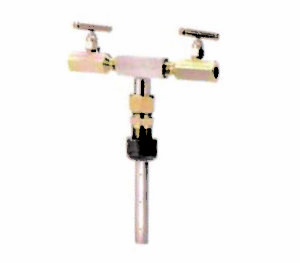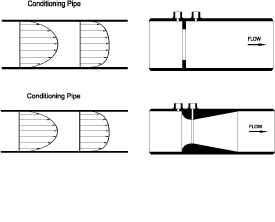Griswold Controls’ Modified Venturi with Disturbed Flow Technology
When a Contractor’s Manual Balance Valve readings are anything less than ±1% accurate, the engineer’s system design is costing someone money. In many installations, contractors may sacrifice accuracy for space considerations since traditional Manual Balance Valves require straight pipe length upstream and downstream. Straight pipe length is not required with Griswold’s Disturbed Flow Measurement used exclusively in the QuickSet Manual Balance Valves. When the engineer specifies a QuickSet, they can count on the balancing contractor getting a ±1% test accuracy no matter what space the contractor has to install the valve. The engineer’s QuickSet specification guarantees the energy efficiency and lower operating cost desired by the owner.
What is Disturbed Flow Technology?
Disturbed Flow Measurement is a new design strategy which allows installation of 2-1/2″–18″ QuickSet manual balance valves with no straight-run pipe required at inlet or outlet resulting in accurate flow measurement of ±1%.
Traditional Technologies to Measure Flow
Pitot Tube
The Pitot tube is a tube inserted into a pipe or valve. One reads the pressure difference from the front and back side of the tube. Drawbacks: requires 10 diameters straight pipe minimum at inlet to condition flow. Pitot tubes have a small diameter and can easily clog.
Orifice Plate
The Orifice plate is merely a plate in the valve with an orifice in the middle through which the flow must travel. Flow is measured both before the orifice plate (high pressure) and after (low pressure) Drawbacks: requires 10 diameters straight pipe minimum at inlet to condition flow. Sudden contraction/expansion causes high permanent psid/ low Cv. Engineers all agree that an orifice plate is the least accurate way to measure flow because they provide flow readings that are off by as much as 30%.
Classic Venturi
The venturi is a cast or machined shape through which the flow travels. Flow is measured both before the venturi (high pressure) and at the throat diameter of the single cavity chamber (low pressure). Gradual contraction/expansion generates a lower permanent psid due to static regain so the pump sees lower pressure requirements. Drawbacks: requires 4 diameters straight pipe minimum at inlet to condition flow.

Do you have a question on this Application Tip or any of the Griswold Controls products? Fill out the form below and someone from Griswold Controls will get back to you shortly.
How does Disturbed Flow Measurement work?
Griswold Controls welds a spun steel venturi into a pipe. Disturbed fluid is channeled through the throat of a venturi with a multiport Piezo Ring. Since different velocities create different pressures, the fluid passes from high pressure to low pressure through the Piezo ports into the hollow secondary chamber between the pipe wall and the venturi. This creates a buffered circular flow in the secondary chamber which averages the low pressure readings, enabling an accurate ±1% psid reading through the second P/T port.
Is the high pressure reading affected?
At the entrance to the venturi, there is a region where fluid velocity is zero, creating a static pressure zone
(highest possible pressure). This eliminates the need to regularize the velocity and pressure, as in the secondary chamber.


Questions about this application? Contact info@GriswoldControls.com, call 949.559.6000 or fill out the contact form on this page.

